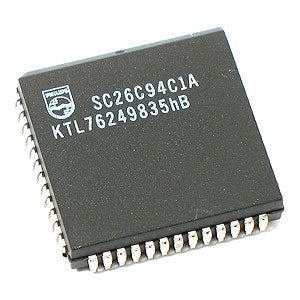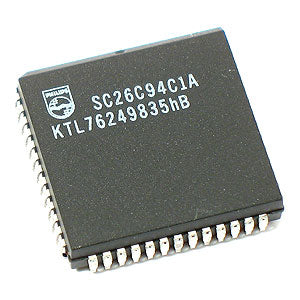Skip to product information
Each receiver is buffered with eight character FIFOs (first-in-first-out memories) and one shift register to minimize the potential for receiver overrun and to reduce interrupt overhead in interrupt driven systems. In addition, a handshaking capability is provided to disable a remote UART transmitter when the receiver buffer is full. (RTS control) The SC26C94C1A provides a power-down mode in which the oscillator is stopped and the register contents are stored. This results in reduced power consumption on the order of several magnitudes. The QUART is fully TTL compatible and operates from a single +5V power supply.
Features:
Parity, framing, and overrun error detection
False start bit detection
Line break detection and generation
Programmable channel mode: Normal (full-duplex), automatic echo, local loop back, remote loopback
Programmable interrupt priorities
Identification of highest priority interrupt
Global interrupt register set provides data from interrupting channel
Vectored interrupts with programmable vector format
IACKN and DTACKN signals
Built-in baud rate generator with choice of 18 rates
Four I/O pins per UART for modem controls, clocks, etc.
On-chip crystal oscillator
TTL compatible
Single +5V power supply with low power mode
Two multifunction programmable 16-bit counter/timers
1MHz 16x mode operation
30ns data bus release time
?Watch Dog? timer for each receiver
Datasheet Available:Phillips SC26C94C1A
PLCC 52 package. Manufactured by Phillips.
A20371
A20371 - SC26C94C1A Quad Universal Receiver/Transmitter (Phillips)
Detailed Description
The SC26C94C1A quad universal asynchronous receiver/transmitter (QUART) combines four enhanced Philips Semiconductors industry-standard UARTs with an innovative interrupt scheme that can vastly minimize host processor overhead. It is implemented using Philips Semiconductors? high-speed CMOS process that combines small die size and cost with low power consumption. The operating speed of each receiver and transmitter can be selected independently at one of eighteen fixed baud rates, a 16X clock derived from a programmable counter/timer, or an external 1X or 16X clock. The baud rate generator and counter/timer can operate directly from a crystal or from external clock inputs. Theability to independently program the operating speed of the receiver and transmitter make the QUART particularly attractive for dual-speed channel applications such as clustered terminal systems.Each receiver is buffered with eight character FIFOs (first-in-first-out memories) and one shift register to minimize the potential for receiver overrun and to reduce interrupt overhead in interrupt driven systems. In addition, a handshaking capability is provided to disable a remote UART transmitter when the receiver buffer is full. (RTS control) The SC26C94C1A provides a power-down mode in which the oscillator is stopped and the register contents are stored. This results in reduced power consumption on the order of several magnitudes. The QUART is fully TTL compatible and operates from a single +5V power supply.
Features:
Parity, framing, and overrun error detection
False start bit detection
Line break detection and generation
Programmable channel mode: Normal (full-duplex), automatic echo, local loop back, remote loopback
Programmable interrupt priorities
Identification of highest priority interrupt
Global interrupt register set provides data from interrupting channel
Vectored interrupts with programmable vector format
IACKN and DTACKN signals
Built-in baud rate generator with choice of 18 rates
Four I/O pins per UART for modem controls, clocks, etc.
On-chip crystal oscillator
TTL compatible
Single +5V power supply with low power mode
Two multifunction programmable 16-bit counter/timers
1MHz 16x mode operation
30ns data bus release time
?Watch Dog? timer for each receiver
Datasheet Available:Phillips SC26C94C1A
PLCC 52 package. Manufactured by Phillips.
A20371
![]() WARNING: This product can expose you to chemicals including lead, which is known to the State of California to cause cancer. For more information, go to www.P65Warnings.ca.gov - Why is this here?
WARNING: This product can expose you to chemicals including lead, which is known to the State of California to cause cancer. For more information, go to www.P65Warnings.ca.gov - Why is this here?




